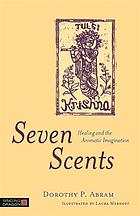Seven Scents. Healing and the Aromatic Imagination. / Dorothy P. Abram, 2017. London and Philadelphia: Singing Dragon. 150 p. Illustrations in black and white.

Scent. Fragrance. The words evoke concepts of lavishness, abundance of floral magic and beauty. Even words like aroma, and the British “odour” allude to a particular experience in the mind—the kind we all share, yet individually mark and digest.
Entertaining and fun to read, many books on fragrance are purveyors of dreams and ideas that inspire. Other works, books, articles and online posts attempt to scientifically define what aromas do neurologically, along the path of a sensory experience. Following that, there’s a shift in our outlook.
Yet there’s another kind of book on scent that’s rarely found. Such a book offers a view of natural plants and their connections between the physical and spiritual realms. Those realms are beyond what a study can describe, beyond the isolation of science. Seven Scents is that kind of book.
Abram’s treatment of her subject is academic in tone—each supporting concept is duly examined for ancillary clues. Footnotes accompany each idea in the book. Since her topic is not that well-known in our culture, providing background for the ideas assures you, the reader, will take her seriously.
And why not? Each of the stories in Seven Scents informs us of messages from the plant world. In these accounts, human beings who were open to the idea could sense the unseen potential of a tree or flower. They expected the influence of scent to inspire and support them, to lift them up. In each case, from Sandalwood to Jasmine, we read about a human dilemma or crisis and their release from it. All because of a tree’s or flower’s ability to transcend.
The first chapter on Sandalwood appeals in a poetic sense. It details the affliction of an Indian saint and the woman healer/spiritual guide who aided his recovery. A shaman, Bhairavi Brahmani, administered a healing and cooling salve to the stricken priest. Ramakrishna (d. 1886), being released from his illness, arose from an agonizing fever to personify a divinity and thus devote himself to the goddess Kali in whose temple he presided.
Sandalwood (Santalum album), a now highly endangered tree, is native to India. Its spirit or element is cooling and highly regarded there since its early history. Curiously, the Sandalwood tree grows as part of a colony of trees or in parasitic relationship with other tree roots. The heartwood and roots cultivate and store essential oil over a 60 to 80-year lifespan while the tree matures.
In Seven Scents, stories from Hindu culture and the Bible successfully mix both well-known and mysterious symbols. In a second chapter on biblical fragrances, author Abram narrates the story of Spikenard, an alchemy for pain and suffering. With this precious oil known to cause sleep (and therefore both mental and physical transformation), Mary of Bethany, sister of Lazarus (p. 123), anoints the feet of Jesus. In Jesus’ words, her healing had given him salve for the wounds he was to bear and she would be remembered for this for all time.
Spikenard (Nardostachys jatamansi), is native to the mountainous regions of Himalaya, Tibet, India and southwest China (p. 121). Spikenard acquired several common names, while not unusual attests to its popularity and having been traded from Asia to the West early in its history.
For individual plant substances, rather than do research into the vibrational resonance we tend to look for studies and neatly arranged data. In another way of looking at a plant’s potential (see Noted Review: Essential Oils in Spiritual Practice, link here), we witness the resonance of a whole plant and realize its strengths in providing self-protection.
Every age has its religion: ours may be centered around science. Yet in the end we’re less than exacting with our science, we tend to interpret only part of the message. We’re sometimes overwhelmed by plentiful resources and then make choices based on collective reasoning.
And in each human life, troubles, stress, and the like, stop us or compete with us to a greater or lesser extent. For physical and spiritual healing—why don’t we broaden our beliefs to include responsive vibrations and other resources from the plant world? If a statement is not backed up by recent studies, it might have the support of hundreds or even thousands of years of advantageous use. Such evidence is not insignificant in any way.
I could read about more precious plant oils and the transition of human suffering or the alchemy of immense change in their lives. But the strong message in this little book of seven tales is rich with implication for my own thinking about plant oils and the gifts they provide us.
See the author’s bio on Singing Dragon—the publisher’s website.



